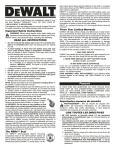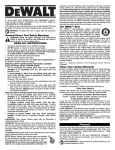Download DeWalt DW9050 Instruction manual
Transcript
e) Maintain power tools. Check for misalignment or binding of moving parts, breakage of parts and any other condition that may affect the power tools operation. If damaged, have the power tool repaired before use. Many accidents are caused by poorly maintained power tools. f) Keep cutting tools sharp and clean. Properly maintained cutting tools with sharp cutting edges are less likely to bind and are easier to control. g) Use the power tool, accessories and tool bits etc., in accordance with these instructions and in the manner intended for the particular type of power tool, taking into account the working conditions and the work to be performed. Use of the power tool for operations different from those intended could result in a hazardous situation. DC527 18 Volt Fluorescent Area Light DC528 14.4/12 Volt Fluorescent Area Light INSTRUCTION MANUAL 5) BATTERY TOOL USE AND CARE a) Ensure the switch is in the off position before inserting battery pack. Inserting the battery pack into power tools that have the switch on invites accidents. b) Recharge only with the charger specified by the manufacturer. A charger that is suitable for one type of battery pack may create a risk of fire when used with another battery pack. c) Use power tools only with specifically designated battery packs. Use of any other battery packs may create a risk of injury and fire. d) When battery pack is not in use, keep it away from other metal objects like paper clips, coins, keys, nails, screws, or other small metal objects that can make a connection from one terminal to another. Shorting the battery terminals together may cause burns or a fire. e) Under abusive conditions, liquid may be ejected from the battery, avoid contact. If contact accidentally occurs, flush with water. If liquid contacts eyes, additionally seek medical help. Liquid ejected from the battery may cause irritation or burns. The following are trademarks for one or more DEWALT power tools: the yellow and black color scheme; the “D” shaped air intake grill; the array of pyramids on the handgrip; the kit box configuration; and the array of lozenge-shaped humps on the surface of the tool. 6) SERVICE a) Have your power tool serviced by a qualified repair person using only identical replacement parts. This will ensure that the safety of the power tool is maintained. Safety Rules for Fluorescent Area Lights WARNING: Burn hazard. Do not operate flashlight or charger near flammable liquids or in gaseous or explosive atmospheres. Internal sparks may ignite fumes causing personal injury. WARNING: Shock Hazard. Remove battery pack before replacing the fluorescent tube. WARNING: Lens and fluorescent tube become hot during use. • During or immediately after use, don’t lay area light flat on lens surface. • Don’t touch lens surface when tube is lit or immediately after use. • Handle light with care around any flammable surface. • If fluorescent tube has been lit, let it cool for several minutes before changing tube. • Vision may be impaired when looking directly into fluorescent light. • Do not expose light or charger to wet or damp areas. Do not expose light or charger to rain or snow. • Do not wash light or charger with water or allow water to get inside light or charger. Do not submerge light in water at any time. • While light is in use, do not cover with cloth or other flammable materials due to increased risk of fire. • Do not operate without lens cover assembly attached. CAUTION: When not in use, place tool on its side on a stable surface where it will not cause a tripping or falling hazard. Some tools with large battery packs will stand upright on the battery pack but may be easily knocked over. • The label on your tool may include the following symbols. V ..........volts A ................amperes W ..............watts Hz ........hertz ..............alternating current min ........minutes no ..............no load speed ......direct current ........Class II Construction …/min ........revolutions or reciprocation per minute ..............safety alert symbol ........earthing terminal Important Safety Instructions for Battery Packs General Safety Rules WARNING! Read all instructions. Failure to follow all instructions listed below may result in electric shock, fire and/or serious injury. The term “power tool” in all of the warnings listed below refers to your mains-operated (corded) power tool or battery-operated (cordless) power tool. SAVE THESE INSTRUCTIONS 1) WORK AREA SAFETY a) Keep work area clean and well lit. Cluttered or dark areas invite accidents. b) Do not operate power tools in explosive atmospheres, such as in the presence of flammable liquids, gases or dust. Power tools create sparks which may ignite the dust or fumes. c) Keep children and bystanders away while operating a power tool. Distractions can cause you to lose control 2) ELECTRICAL SAFETY a) Power tool plugs must match the outlet. Never modify the plug in any way. Do not use any adapter plugs with earthed (grounded) power tools. Unmodified plugs and matching outlets will reduce risk of electric shock b) Avoid body contact with earthed or grounded surfaces such as pipes, radiators, ranges and refrigerators. There is an increased risk of electric shock if your body is earthed or grounded. c) Do not expose power tools to rain or wet conditions. Water entering a power tool will increase the risk of electric shock d) Do not abuse the cord. Never use the cord for carrying, pulling or unplugging the power tool. Keep cord away from heat, oil, sharp edges or moving parts. Damaged or entangled cords increase the risk of electric shock. Replace or repair damaged cords. Make sure your extension cord is in good condition. Use only 3-wire extension cords that have 3-prong grounding-type plugs and 3-pole receptacles that accept the tool’s plug. e) When operating a power tool outdoors, use an extension cord suitable for outdoor use. Use of a cord suitable for outdoor use reduces the risk of electric shock. When using an extension cord, be sure to use one heavy enough to carry the current your product will draw. An undersized cord will cause a drop in line voltage resulting in loss of power and overheating. The following table shows the correct size to use depending on cord length and nameplate ampere rating. If in doubt, use the next heavier gage. The smaller the gage number, the heavier the cord. Recommended Minimum Wire Size for Extension Cords Total Length of Cord 75 ft. 100 ft. 125 ft. 150 ft. 175 ft. 50 ft. 25 ft. 7.6 m 15.2 m 22.9 m 30.5 m 38.1 m 45.7 m 53.3 m Wire Size AWG 18 18 16 16 14 14 12 3) PERSONAL SAFETY a) Stay alert, watch what you are doing and use common sense when operating a power tool. Do not use a power tool while you are tired or under the influence of drugs, alcohol or medication. A moment of inattention while operating power tools may result in serious personal injury. b) Use safety equipment. Always wear eye protection. Safety equipment such as dust mask, non-skid safety shoes, hard hat, or hearing protection used for appropriate conditions will reduce personal injuries. c) Avoid accidental starting. Ensure the switch is in the off-position before plugging in. Carrying power tools with your finger on the switch or plugging in power tools that have the switch on invites accidents. d) Remove any adjusting key or wrench before turning the power tool on. A wrench or a key left attached to a rotating part of the power tool may result in personal injury. e) Do not overreach. Keep proper footing and balance at all times. This enables better control of the power tool in unexpected situations. f) Dress properly. Do not wear loose clothing or jewellery. Keep your hair, clothing and gloves away from moving parts. Loose clothes, jewellery or long hair can be caught in moving parts. Air vents often cover moving parts and should also be avoided. g) If devices are provided for the connection of dust extraction and collection facilities, ensure these are connected and properly used. Use of these devices can reduce dust-related hazards. 4) POWER TOOL USE AND CARE a) Do not force the power tool. Use the correct power tool for your application. The correct power tool will do the job better and safer at the rate for which it was designed. b) Do not use the power tool if the switch does not turn it on and off. Any power tool that cannot be controlled with the switch is dangerous and must be repaired. c) Disconnect the plug from the power source and/or the battery pack from the power tool before making any adjustments, changing accessories, or storing power tools. Such preventive safety measures reduce the risk of starting the power tool accidentally. d) Store idle power tools out of the reach of children and do not allow persons unfamiliar with the power tool or these instructions to operate the power tool. Power tools are dangerous in the hands of untrained users. The DC527 uses an 18 Volt DEWALT battery pack. The DC528 can use a 12 Volt or 14.4 Volt DEWALT battery pack. When ordering replacement battery packs, be sure to include catalog number and voltage: Extended Run-Time battery packs deliver more run-time than standard battery packs. Consult the chart at the end of this manual for compatibility of chargers and battery packs. NOTE: Your tool will accept either standard or Extended Run Time battery packs. However, be sure to select proper voltage. Batteries slowly lose their charge when they are not on the charger, the best place to keep your battery is on the charger at all times. The battery pack is not fully charged out of the carton. Before using the battery pack and charger, read the safety instructions below. Then follow charging procedures outlined. READ ALL INSTRUCTIONS • Do not incinerate the battery pack even if it is severely damaged or is completely worn out. The battery pack can explode in a fire. • A small leakage of liquid from the battery pack cells may occur under extreme usage or temperature conditions. This does not indicate a failure. However, if the outer seal is broken and this leakage gets on your skin: a. Wash quickly with soap and water. b. Neutralize with a mild acid such as lemon juice or vinegar. c. If battery liquid gets into your eyes, flush them with clean water for a minimum of 10 minutes and seek immediate medical attention. (Medical note: The liquid is 25-35% solution of potassium hydroxide.) • Charge the battery packs only in DEWALT chargers. • DO NOT splash or immerse in water or other liquids. • Do not store or use the tool and battery pack in locations where the temperature may reach or exceed 105°F (such as outside sheds or metal buildings in summer). DANGER: Electrocution hazard. Never attempt to open the battery pack for any reason. If battery pack case is cracked or damaged, do not insert into charger. Electric shock or electrocution may result. Damaged battery packs should be returned to service center for recycling. NOTE: Battery storage and carrying caps are provided for use whenever the battery is out of the tool or charger. Remove cap before placing battery in charger or tool. WARNING: Fire hazard. Do not store or carry battery so that metal objects can contact exposed battery terminals. For example, do not place battery in aprons, pockets, tool boxes, product kit boxes, drawers, etc., with loose nails, screws, keys, etc. without battery cap. Transporting batteries can possibly cause fires if the battery terminals inadvertently come in contact with conductive materials such as keys, coins, hand tools and the like. The US Department of Transportation Hazardous Material Regulations (HMR) actually prohibit transporting batteries in commerce or on airplanes (i.e., packed in suitcases and carry-on luggage) UNLESS they are properly protected from short circuits. So when transporting individual batteries, make sure that the battery terminals are protected and well insulated from materials that could contact them and cause a short circuit. The RBRC™ Seal The RBRC™ (Rechargeable Battery Recycling Corporation) Seal on the nickel-cadmium battery (or battery pack) indicates that the costs to recycle the battery (or battery pack) at the end of its useful life have already been paid by DEWALT. In some areas, it is illegal to place spent nickel-cadmium batteries in the trash or municipal solid waste stream and the RBRC program provides an environmentally conscious alternative. RBRC™ in cooperation with DEWALT and other battery users, has established programs in the United States to facilitate the collection of spent nickel-cadmium batteries. Help protect our environment and conserve natural resources by returning the spent nickel-cadmium battery to an authorized DEWALT service center or to your local retailer for recycling. You may also contact your local recycling center for information on where to drop off the spent battery. RBRC™ is a registered trademark of the Rechargeable Battery Recycling Corporation. Important Safety Instructions for Battery Chargers SAVE THESE INSTRUCTIONS: This manual contains important safety instructions for battery chargers. • Before using charger, read all instructions and cautionary markings on charger, battery pack, and product using battery pack. DANGER: Electrocution hazard. 120 volts are present at charging terminals. Do not probe with conductive objects. Electric shock or electrocution may result. WARNING: Shock hazard. Do not allow any liquid to get inside charger. Electric shock may result. CAUTION: Burn hazard. To reduce the risk of injury, charge only DEWALT nickel-cadmium rechargeable batteries. Other types of batteries may burst causing personal injury and damage. CAUTION: Under certain conditions, with the charger plugged in to the power supply, the exposed charging contacts inside the charger can be shorted by foreign material. Foreign materials of a conductive nature such as, but not limited to, steel wool, aluminum foil, or any buildup of metallic particles should be kept away from charger cavities. Always unplug the charger from the power supply when there is no battery pack in the cavity. Unplug charger before attempting to clean. • DO NOT attempt to charge the battery pack with any chargers other than the ones in this manual. The charger and battery pack are specifically designed to work together. • These chargers are not intended for any uses other than charging DEWALT rechargeable batteries. Any other uses may result in risk of fire, electric shock or electrocution. • Do not expose charger to rain or snow. • Pull by plug rather than cord when disconnecting charger. This will reduce risk of damage to electric plug and cord. • Make sure that cord is located so that it will not be stepped on, tripped over, or otherwise subjected to damage or stress. • Do not use an extension cord unless it is absolutely necessary. Use of improper extension cord could result in risk of fire, electric shock, or electrocution. • An extension cord must have adequate wire size (AWG or American Wire Gauge) for safety. The smaller the gauge number of the wire, the greater the capacity of the cable, that is 16 gauge has more capacity than 18 gauge. When using more than one extension to make up the total length, be sure each individual extension contains at least the minimum wire size. • Do not place any object on top of charger or place the charger on a soft surface that might block the ventilation slots and result in excessive internal heat. Place the charger in a position away from any heat source. The charger is ventilated through slots in the top and the bottom of the housing. • Do not operate charger with damaged cord or plug — have them replaced immediately. • Do not operate charger if it has received a sharp blow, been dropped, or otherwise damaged in any way. Take it to an authorized service center. • Do not disassemble charger; take it to an authorized service center when service or repair is required. Incorrect reassembly may result in a risk of electric shock, electrocution or fire. • Disconnect the charger from the outlet before attempting any cleaning. This will reduce the risk of electric shock. Removing the battery pack will not reduce this risk. • NEVER attempt to connect 2 chargers together. • The charger is designed to operate on standard household electrical power (120 Volts). Do not attempt to use it on any other voltage. This does not apply to the vehicular charger. FIG. 1 C A D B E G F FIG. 2 FIG. 4 FIG. 5 I H B SAVE THESE INSTRUCTIONS FOR FUTURE USE FIG. 5 Chargers Your tool uses a DEWALT charger. Your battery can be charged in DEWALT 1 Hour Chargers, 15 Minute Chargers or Vehicular 12 Volt Charger. Be sure to read all safety instructions before using your charger. Consult the chart on the back cover of this manual for compatibility of chargers and battery packs. G Charging Procedure DANGER: Electrocution hazard. 120 volts are present at charging terminals. Do not probe with conductive objects. Electric shock or electrocution may result. 1. Plug the charger into an appropriate outlet. 2. Insert the battery pack into the charger. The red (charging) light will blink continuously indicating that the charging process has started. 3. The completion of charge will be indicated by the red light remaining ON continuously. The pack is fully charged and may be used at this time or left in the charger. Indicator Light Operation Switch (Fig. 1) To turn the light on, slide the switch (C) forward. To turn it off, slide the switch back. Replacing the Fluorescent Tube (Fig. 3, 4) Charge Indicators Some chargers are designed to detect certain problems that can arise with battery packs. Problems are indicated by the red light flashing at a fast rate. If this occurs, re-insert battery pack into the charger. If the problem persists, try a different battery pack to determine if the charger is OK. If the new pack charges correctly, then the original pack is defective and should be returned to a service center or other collection site for recycling. If the new battery pack elicits the same trouble indication as the original, have the charger tested at an authorized service center. HOT/COLD PACK DELAY Some chargers have a Hot/Cold Pack Delay feature: when the charger detects a battery that is hot, it automatically starts a Hot Pack Delay, suspending charging until the battery has cooled. After the battery has cooled, the charger automatically switches to the Pack Charging mode. This feature ensures maximum battery life. The red light flashes long, then short while in the Hot Pack Delay mode. PROBLEM POWER LINE Some chargers have a Problem Power Line indicator. When the charger is used with some portable power sources such as generators or sources that convert DC to AC, the charger may temporarily suspend operation, flashing the red light with two fast blinks followed by a pause. This indicates the power source is out of limits. CAUTION: Disconnect battery pack from tool before replacing the fluorescent tube. Such preventative safety measures reduce the risk of personal injury. CAUTION: Burn hazard. Lens or fluorescent tube may be hot immediately after use. CAUTION: Vision may be impaired when looking directly into fluorescent light. CAUTION: If replacing a broken tube, protect your hands before attempting to remove the tube. Do not remove any pieces of broken glass or tube from the socket area with bare hands, or personal injury may occur. NOTE: Use only DEWALT DC5273 13W tube. 1. With one hand on the lens cover assembly (D) and the other hand on the base (E), slowly rotate the cover counterclockwise from its original position. 2. Carefully lift the lens cover assembly up and over the tube. Set aside. 3. Carefully remove the tube from the socket by gently pulling up from the base. Check to ensure the socket and the area around the socket is free of dirt, dust and other contaminants. NOTE: A clear, rubber end cap is mounted inside the top portion of the lens cover assembly This endcap must align with the top of the fluorescent tube in order for the lens cover assembly to fit properly onto the handle. The rubber end cap should be in the correct position when lens cover assembly is removed to allow new tube to fit. 4. Once the new tube is in place, align the slots (H) at the bottom of the lens cover assembly with the slots (I) at the top of the base. 5. Push the lens cover assembly down then rotate it clockwise to lock into place. Hook (Fig. 5) LEAVING THE BATTERY PACK IN THE CHARGER The charger and battery pack can be left connected with the red light glowing indefinitely. The charger will keep the battery pack fresh and fully charged. NOTE: A battery pack will slowly lose its charge when kept out of the charger. If the battery pack has not been kept on maintenance charge, it may need to be recharged before use. A battery pack may also slowly lose its charge if left in a charger that is not plugged into an appropriate AC source. WEAK BATTERY PACKS: Chargers can also detect a weak battery. Such batteries are still usable but should not be expected to perform as much work. In such cases, about 10 seconds after battery insertion, the charger will beep rapidly 8 times to indicate a weak battery condition. The charger will then go on to charge the battery to the highest capacity possible. CAUTION: When hook is in use, do not shake light. Personal injury or property damage may occur. CAUTION: When light is hung by the hook, do not shake the light or object that it is hanging from. Do not hang the light from any electrical wires or anything that it is not secure. Personal injury or property damage may occur. CAUTION: Only use the hook for hanging the area light. The hook is not intended to support additional weight. Do not attach or hang anything additional to the light or risk of breakage may occur. CAUTION: Do not reach with the hook or use the hook to support your weight in any situation. The built-in hook (G) telescopes out of the lens cover assembly (D). This hook locks into place in the down position and when fully extended, as shown in Figure 5. The hook rotates 360 degrees and can be locked at 45-degree positions when fully extended. Important Charging Notes MAINTENANCE DeWalt electric All charge times are approximate. Actual charge time may vary. Read the instruction manual for more specific information. DW0246 DW9109 60 X X 60 X 60 X 30 X 45 X 60 X 45 X 30 X 60 X 45 X 30 X X X 45 X 30 X X X 30 12 Volts DC011 DW0249 X 60 60 X 60 X 30 X 45 X 60 X 45 X 30 X 60 X 45 X 30 X X X 45 X 30 X X X 30 X DW9216 DW9117 DW911 X X X 60 20 60 60 20 60 30 12 30 45 15 45 60 20 60 45 15 45 30 12 30 60 20 60 45 15 45 30 12 30 X X X 45 15 45 30 12 30 X X X 30 12 30 DW9116 X 60 60 30 45 60 45 30 60 45 30 X 45 30 X 30 120 Volts DW9107 DW9108 X X X 60 X 60 X 30 X 45 60 60 45 45 30 30 60 60 45 45 30 30 X X 45 45 30 30 X X 30 30 X Indicates that the battery pack is not compatible with that specific charger. NOTE: Make sure your battery pack is fully charged. To insert the battery pack (A) into your fluorescent area light, slide it into the end of the light until it snaps into place. To remove the battery pack, depress the release buttons (B) and withdraw the battery pack. DW9106 DW9118 X X X X X X X X X X 90 115 45 90 60 60 90 115 60 90 45 60 40 X 60 90 45 60 40 X 45 60 OPERATION Installing and Removing the Battery Pack (Fig. 2) Cat Number Voltage DW0242 24 DC9096 18 DW9096 18 DW9098 18 DW9099 18 DC9091 14.4 DW9091 14.4 DW9094 14.4 DC9071 12 DW9071 12 DW9072 12 DW9050 12 DW9061 9.6 DW9062 9.6 DW9048 9.6 DW9057 7.2 E. Base F. Lens G. Hook DEWALT Battery and Charger Systems Battery pack Release buttons Switch Lens cover assembly Use only mild soap and a damp cloth to clean the tool. Many household cleaners contain chemicals which could seriously damage plastic. Also, do not use gasoline, turpentine, lacquer or paint thinner, dry cleaning fluids or similar products. Never let any liquid get inside the tool; never immerse any part of the tool into a liquid. Chargers/Charge Time – Chargeurs/Durée de charge (Minutes) – Cargadores de baterías/Tiempo de carga (Minutos) A. B. C. D. Cleaning Output Components (Fig. 1) • MAINTAIN TOOL WITH CARE. Keep fluorescent tube area clean for best and safest performance. • Do not attempt to repair the area light. To assure product safety and reliability, repairs, maintenance, and adjustments should be performed by authorized DEWALT service centers. Battery 1. Longest life and best performance can be obtained if the battery pack is charged when the air temperature is between 65°F and 75°F (18°- 24°C). DO NOT charge the battery pack in an air temperature below +40°F (+4.5°C), or above +105°F (+40.5°C). This is important and will prevent serious damage to the battery pack. 2. The charger and battery pack may become warm to touch while charging. This is a normal condition, and does not indicate a problem. To facilitate the cooling of the battery pack after use, avoid placing the charger or battery pack in a warm environment such as in a metal shed, or an uninsulated trailer. 3. If the battery pack does not charge properly: a. Check current at receptacle by plugging in a lamp or other appliance b. Check to see if receptacle is connected to a light switch which turns power off when you turn out the lights. c. Move charger and battery pack to a location where the surrounding air temperature is approximately 65°F - 75°F (18°- 24°C). d. If charging problems persist, take the tool, battery pack and charger to your local service center. 4. The battery pack should be recharged when it fails to produce sufficient power on jobs which were easily done previously. DO NOT CONTINUE to use under these conditions. Follow the charging procedure. You may also charge a partially used pack whenever you desire with no adverse affect on the battery pack. 5. Under certain conditions, with the charger plugged into the power supply, the exposed charging contacts inside the charger can be shorted by foreign material. Foreign materials of a conductive nature such as, but not limited to, steel wool, aluminum foil, or any buildup of metallic particles should be kept away from charger cavities. Always unplug the charger from the power supply when there is no battery pack in the cavity. Unplug charger before attempting to clean. 6. Do not freeze or immerse charger in water or any other liquid. WARNING: Don’t allow any liquid to get inside charger. Electric shock may result. CAUTION: Never attempt to open the battery pack for any reason. If the plastic housing of the battery pack breaks or cracks, return to a service center for recycling. Power tools











